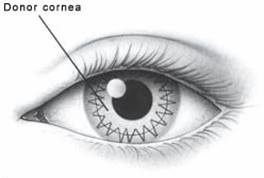
CORNEAL TRANSPLANT
What is a corneal transplant?
The cornea is the clear dome on the front of the eye. A corneal transplant is procedure in which a cloudy or misshaped cornea is removed and replaced with a clear one.
What are some causes of corneal clouding or injury?
Common causes of corneal clouding or decreased vision from cornea problems include:
- Fuchs corneal dystrophy, which is a common condition that causes swelling and clouding of the cornea.
- Keratoconus, where the cornea becomes increasingly misshapen.
- Surgeries, especially cataract surgery.
- Conditions that cause scarring, like cuts, burns, or infections.
- Other conditions, including congenital eye diseases.

Where does corneal transplant tissue come from?
Corneas for transplant come from donors. An eye bank examines, protects, and stores the donated corneas. Before a donated cornea is used, it is tested for clarity and diseases. Only clear, healthy corneas are used.
What happens during the procedure?
The center of the cloudy or damaged cornea, about the size of a dime, is removed. Then the clear center of a donated cornea is sewn into its place. If your eye has a cataract, it can be removed at the same time. Your surgeon will put a patch over your eye. Depending on the type of anesthesia, you will be sent home 1 to 2 hours after the surgery.
What happens after the procedure?
Your doctor will examine your eye the next day. There is usually very little discomfort after surgery. It is important to avoid bending, heavy lifting, and exercise for at least 2 weeks. Wear glasses or a shield at all times to protect your eye. You will use eyedrops several times a day for a long time. They help prevent infection and also rejection of the new cornea. It takes time for good vision to return after this surgery.
What are the benefits of this procedure?
Your vision is clearer than it was when you had a cloudy or injured cornea. How successful the surgery is depends on the underlying reason for having the transplant and your overall eye health.
What are the risks of surgery?
Rarely, a serious infection or bleeding can permanently damage your eyes. Your eye doctor will take every possible precaution to prevent this. A few people with corneal transplants will have a "graft failure." This means that transplant becomes too cloudy to allow good vision. This can be because the body rejects the new cornea or for other unknown reasons. Uncontrolled high eye pressure, history of inflammation in the cornea, blood vessels within the cornea are some things that increases the risk. If you injure the eye with the corneal transplant it can cause more severe damage than is caused to an eye without a transplant. This is because the stitches are not as strong as the strength of the natural tissue.
When should I call the doctor?
Call the doctor immediately if you:
- have unusual pain.
- have a sudden loss of vision
- have a lot of drainage from your eye.
This content is reviewed periodically and is subject to change as new health information becomes available. The information is intended to inform and educate and is not a replacement for medical evaluation, advice, diagnosis or treatment by a healthcare professional.
